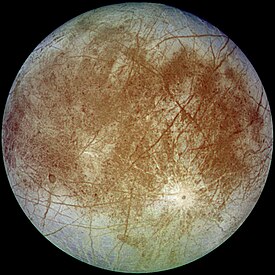Europa (moon)

|
|||||||||
| Discovery | |||||||||
|---|---|---|---|---|---|---|---|---|---|
| Discovered by |
Galileo Galilei Simon Marius |
||||||||
| Discovery date | 8 January 1610 | ||||||||
| Designations | |||||||||
| Jupiter II | |||||||||
| Adjectives | Europan | ||||||||
| Orbital characteristics | |||||||||
| Epoch 8 January 2004 | |||||||||
| Periapsis | 664862 km | ||||||||
| Apoapsis | 676938 km | ||||||||
|
Mean orbit radius
|
670900 km | ||||||||
| Eccentricity | 0.009 | ||||||||
| 3.551181 d | |||||||||
|
Average orbital speed
|
13.740 km/s | ||||||||
| Inclination | 0.470° (to Jupiter's equator) 1.791° (to the ecliptic) |
||||||||
| Satellite of | Jupiter | ||||||||
| Physical characteristics | |||||||||
|
Mean radius
|
1560.8±0.5 km (0.245 Earths) | ||||||||
| 3.09×107 km2 (0.061 Earths) | |||||||||
| Volume | 1.593×1010 km3 (0.015 Earths) | ||||||||
| Mass | (4.799844±0.000013)×1022 kg (0.008 Earths) | ||||||||
|
Mean density
|
3.013±0.005 g/cm3 | ||||||||
| 1.314 m/s2 (0.134 g) | |||||||||
| 0.346±0.005 (estimate) | |||||||||
| 2.025 km/s | |||||||||
| Synchronous | |||||||||
| 0.1° | |||||||||
| Albedo | 0.67 ± 0.03 | ||||||||
|
|||||||||
| 5.29 (opposition) | |||||||||
| Atmosphere | |||||||||
|
Surface pressure
|
0.1 µPa (10−12bar) | ||||||||
Europa ![]() i/jʊˈroʊpə/ (Jupiter II), is the smallest of the four Galilean moons orbiting Jupiter, and the sixth-closest to the planet. It is also the sixth-largest moon in the Solar System. Europa was discovered in 1610 by Galileo Galilei and was named after Europa, the legendary mother of King Minos of Crete and lover of Zeus (the Greek equivalent of the Roman god Jupiter).
i/jʊˈroʊpə/ (Jupiter II), is the smallest of the four Galilean moons orbiting Jupiter, and the sixth-closest to the planet. It is also the sixth-largest moon in the Solar System. Europa was discovered in 1610 by Galileo Galilei and was named after Europa, the legendary mother of King Minos of Crete and lover of Zeus (the Greek equivalent of the Roman god Jupiter).
Slightly smaller than Earth's Moon, Europa is primarily made of silicate rock and has a water-ice crust and probably an iron–nickel core. It has a tenuous atmosphere composed primarily of oxygen. Its surface is striated by cracks and streaks, whereas craters are relatively rare. In addition to Earth-bound telescope observations, Europa has been examined by a succession of space probe flybys, the first occurring in the early 1970s.
...
Wikipedia
